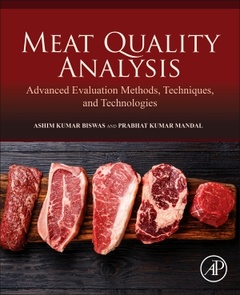Description
Meat Quality Analysis
Advanced Evaluation Methods, Techniques, and Technologies
Coordinators: Biswas Ashim Kumar, Mandal Prabhat
Language: English
Subjects for Meat Quality Analysis:
458 p. · 19x23.3 cm · Paperback
Description
/li>Contents
/li>Biography
/li>Comment
/li>
Meat Quality Analysis: Advanced Evaluation Methods, Techniques, and Technologies takes a modern approach to identify a compositional and nutritional analysis of meat and meat products, post-mortem aging methods, proteome analysis for optimization of the aging process, lipid profiles, including lipid mediated oxidations, meat authentication and traceability, strategies and detection techniques of potential food-borne pathogens, pesticide and drug residues, including antimicrobial growth promoters, food preservatives and additives, and sensory evaluation techniques. This practical reference will be extremely useful to researchers and scientists working in the meat industry, but will also be valuable to students entering fields of meat science, quality and safety.
SECTION-1 Current perspectives of meat quality evaluation 1. Current perspectives of meat quality evaluation: Techniques, technologies and challenges
SECTION-2 Advances in carcass quality evaluation and nutritional composition of meat 2. Methods for nutritional quality analysis of meat 3. Non-destructive methods for carcass and meat quality evaluation
SECTION-3 Post-mortem ageing and meat quality evaluation 4. Meat tenderization 5. Biochemical changes of post-mortem meat during ageing process and strategies to improve meat quality 6. Advances in evaluation of post-mortem ageing in meat 7. Calpain assisted post-mortem ageing of meat and its detection methods
SECTION-4 Molecular basis of meat colour development and detection 8. Molecular basis of meat colour
SECTION-5 Meat authenticity and traceability 9. Molecular techniques for speciation of meat 10. Meat traceability and certification in meat supply chain
SECTION-6 Chemical residues in meat and their detection techniques 11. Residues of harmful chemicals and their detection techniques
SECTION-7 Food preservatives/additives in meat and their detection 12. Use of food preservatives/additives in meat and their detection techniques
SECTION-8 Detection and prevention of lipid oxidation products 13. Lipids and lipid oxidation products and their detection and strategies to prevent lipid oxidation 14. Plant antioxidants, extraction strategies and their application in meat
SECTION-9 Strategies for elimination and detection of food-borne pathogens 15. Strategies for elimination of food-borne pathogens, their influensive detection techniques and drawbacks 16. Modern techniques for rapid detection of meat borne pathogens
SECTION-10 Modern biological concept of meat deterioration and its detection 17. Spoilage bacteria and meat quality 18. Modern concept of deterioration and detection of spoilage in meat and meat products
SECTION-11 Proteomic and genomic tools in meat quality evaluation 19. Application of proteomic tools in meat quality evaluation 20. Application of genomics tools in meat quality evaluation
SECTION-12 Sensory evaluation techniques 21. Advanced sensory evaluation techniques for meat and meat products
Dr. Prabhat Mandal has long experience of new meat product development, food safety and quality evaluation of meat products including use of natural preservatives and functional additives including use of natural antimicrobial. Worked on analysis of various biochemical compounds, sensory evaluation, texture profile analysis and lipid oxidation products in meat products.
- Presents focused detection techniques for reducing or eliminating foodborne pathogens from meat
- Includes strategies and methods on how to better understand meat authenticity and traceability, including meat speciation
- Provides tables, figures and illustrations to facilitate a better understanding of techniques and methods
These books may interest you

The Science of Meat Quality 222.68 €

Handbook of Meat and Meat Processing 329.31 €


